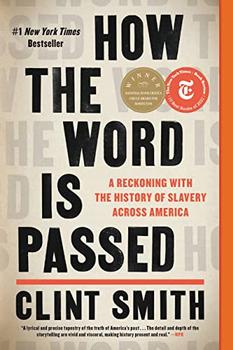Page 1 of 1
There are currently 2 reader reviews for How the Word Is Passed
Write your own review!
 Cathryn Conroy
This Book Will Make Most Readers Uncomfortable…Very Uncomfortable. And That's a Good Thing.
Cathryn Conroy
This Book Will Make Most Readers Uncomfortable…Very Uncomfortable. And That's a Good Thing.
Sometimes the best books are the books that make you uncomfortable. Make you squirm. Make you rethink what you thought was true. Make you realize that myths are not facts and should never be treated as such. Make you realize the harm of not holding history and historians to the highest level of fact-checking.
This is that book.
Written by Clint Smith, this is a most unusual book about the history of chattel slavery, and I dare anyone to read it and not feel uncomfortable—as in guilty by association. But don't be daunted by that because this really is a unique way to look at the tragedy and horror of slavery in the United States. And note that I did not write "slavery in the Southern United States." That is one of the surprises of this book. Slavery was also alive and well in the North. Did you know that in 1855, the mayor of New York City pushed for the city to become an independent city-state so it could secede from the Union along with the Southern states to protect the city's slaveholding interests? I didn't.
To write this book, Smith became a tourist, visiting sites in the United States and Senegal that commemorate in some way the slave trade, slavery, and its aftermath, including Thomas Jefferson's Monticello in Charlottesville, Virginia, Angola prison in Louisiana, Blandford Cemetery in Petersburg, Virginia, the Whitney Plantation in Wallace, Louisiana, as well as Galveston, Texas, New York City, and Gorée Island off Senegal. He also interviewed historians and experts. He interviewed other tourists like himself. He researched in libraries. He validated some myths, while extinguishing others.
Here are some of the many things readers will learn from this most unusual travelogue:
• Find out the extreme dichotomy between the legends and myths of Thomas Jefferson as a benevolent slaveholder and the reality of how he actually treated his slaves.
• The largest slave market in the United States was in Charleston, South Carolina. No surprise there. But this may shock you: The second largest slave market in the United States was in New York City.
• Find out the little-known relationship between the Statue of Liberty and the abolition of slaves. This was one of its first symbolic meanings, but it didn't stick. Why?
• Learn the history of Juneteenth and how Texas, not known for its liberal propensities, led the rest of the nation in establishing this as a federal holiday.
• Find out how spirits and bodies were first broken in the House of Slaves on Gorée Island off Senegal that has now become a place where people of all colors are forced to confront the history of the transatlantic slave trade.
• Learn how modern-day European economic prosperity is directly related to Africans who were enslaved on plantations in the United States 200 to 300 years ago.
One of the distinguishing features of this book is the nearly poetic descriptions of everything from someone's hair, eye color, or trails of sweat (yes, sweat!) to the sunlight's colorful rays on a building. I was so entranced by this that I did a little research of my own and discovered that author Clint Smith is not only a scholar, but also a published poet. Yeah, that makes sense!
Molly Abbott
Eye opening
I wish I was taught this in school! Now I want to know how I can help change curriculum. Amazing book, lots of facts, Clint puts you in all of the places he visits, I felt as I was there.

 Book Reviewed by:
Book Reviewed by:





